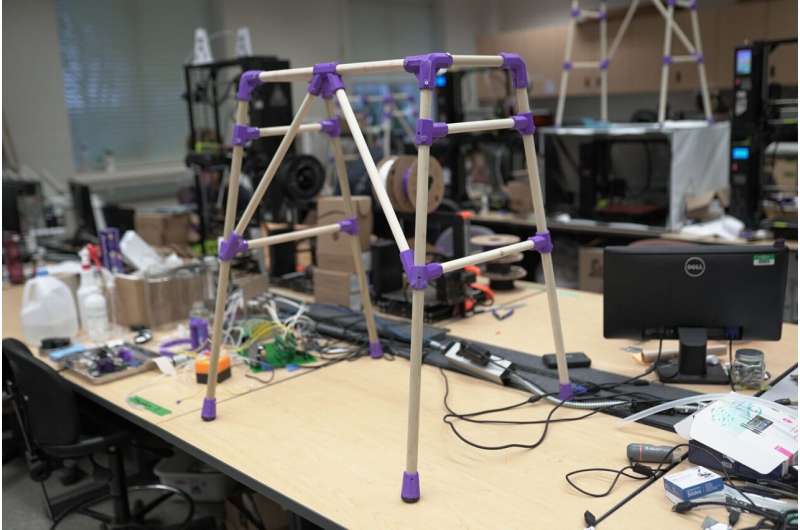This article has been reviewed according to Science X's editorial process and policies. Editors have highlighted the following attributes while ensuring the content's credibility:
fact-checked
trusted source
proofread
New 3D-printed, open-source walker allows people to manufacture their own customizable mobility device

University of Western Ontario engineers have created a new static, four-legged walker that can be constructed from materials and fasteners commonly available from hardware stores like wooden dowels and screws. The joints are all 3D-printed and the entire design is completely open-source, meaning it is freely available online for possible modification and redistribution.
More than 10 percent of adults live with mobility-related disabilities and those physical struggles intensify for people with limited financial resources, whether living in less developed regions of the world or seniors living in poverty.
"Unfortunately, there are still places in the world, whether we're talking about isolated communities in the north, or developing countries, where people simply don't have access to medical technologies or assistive tools like a walker," said Joshua Pearce, the John M. Thompson Chair in Information Technology and Innovation at Western's Thompson Centre for Engineering Leadership & Innovation. "For many, even in developed cities and countries, there are also major financial restraints."
By developing the new open-source walker, Pearce and his collaborators, engineering professor Jacob Reeves and integrated engineering student Anita So, have enabled people to manufacture their own customizable mobility device, which costs significantly less than commercial models that range between $65 and $130. The walker is also available to produce the world over, accelerating accessibility and equity.
"The really big motivator for me [in developing the walker] was the fact that I might be able to make even the slightest difference in someone's life, clear across the world, as they would be able to benefit directly from this low-cost open-source design," said So.
The current design, which can be personalized to any user, should be safely capable of bearing the load of an individual's weight between 78.9 to 93.5 kilograms (approx. 174 to 206 pounds).
As part of research and discovery, So questioned people about their own walkers and learned about usage, satisfaction and frustrations. The Western team was able to include this invaluable personal insight in the design and built a lighter, more affordable walker.
"We really tried to address the problem using globally available materials to increase accessibility and simplicity of the design," said So. "In Canada, we have a great health-care system that provides financial support for people who need these health-care devices but that's not the case for a lot of people in other countries and for those living in remote communities. This walker is for everyone."
This ambitious project comes from the Western frugal biomedical innovation team, which is developing ways to address inequities in Canadian and global health by designing, developing, testing and deploying biomedical devices that meet the needs of the communities where they're most needed.
While the researchers continue to improve the design of the walker, they have also started design work on an open-source, 3D-printed set of crutches.
More information: Anita So et al, Open-Source Designs for Distributed Manufacturing of Low-Cost Customized Walkers, Inventions (2023). DOI: 10.3390/inventions8030079



















